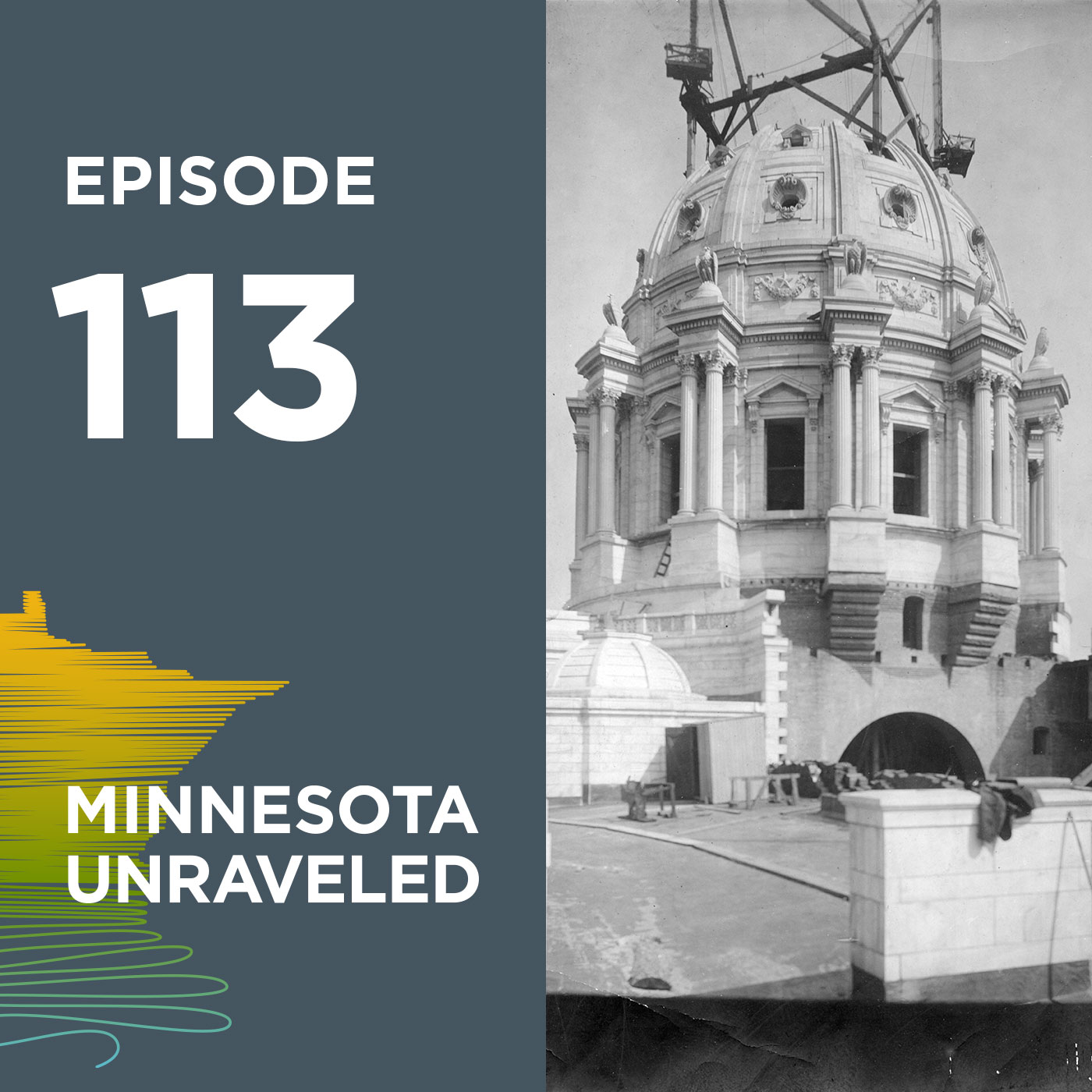Brick by Brick: The African Americans who built the Capitol (episode 113)
The Minnesota State Capitol is a gleaming marble building sitting on a hill — an ode to the Italian Renaissance, topped with an impeccably crafted dome. You’ve probably heard of the mind behind the design, Cass Gilbert, plenty of times. But how did Gilbert’s design influence how the building was made? And just who was it that built the capitol itself?
In this episode, historian and host Dr. Chantel Rodríguez uncovers the unsung builders of this Minnesota monument — African American stone masons. Who were they, and how did they come to the Twin Cities? To answer those questions and more, Chantel spoke with three experts, each of whom pulls from a different well of historical knowledge: Brian Pease, the Site Manager at the State Capitol, John Sielaff, a labor historian, and Marvin Anderson, the grandson of a stone mason who worked on the site.

Guests

Brian Pease
Brian Pease has been with the Minnesota Historical Society since 1987. He holds a BA in history from St. Cloud State University as well as an MA in History from University of Wisconsin-Milwaukee. Since 2008, Pease has been the Site Manager at the Minnesota State Capitol. As site manager, he is responsible for overseeing the capitol’s guided tours, interpretive programming and the care of the original furniture, artwork and artifacts. From 2013 to 2017, during the capitol repair and restoration project, Pease served as an advisor on the history and historic preservation of the building. He also served as the project manager for the Minnesota battle-flag conservation project from 2009 to 2012.

Marvin Roger Anderson
Marvin Roger Anderson is a retired attorney at law and former Minnesota State Law Librarian. Anderson graduated from Morehouse College and continued his education at Hastings College of Law where he received his J.D. Degree. After spending two years in Senegal with the Peace Corps, he returned to Minnesota where he was an ordinance drafter for the city of Minneapolis Department of Civil Rights. Anderson practiced law for several years before earning an MA from the University of Minnesota’s School of Library Science. In 1980, he was appointed State Law Librarian, a position he held for 22 years.
Born and raised in the Rondo neighborhood of St. Paul, Anderson is a community leader and key figure involved in the ongoing efforts to celebrate the past, present and future of St. Paul’s African American community of Rondo. Currently, he serves as the executive director of the Rondo Center of Diverse Expression and the Rondo Commemorative Plaza. Anderson also chairs the board of directors of Reconnect Rondo, where he is instrumental in helping the organization lead a movement in the community for the creation of a Rondo historic district connected by a land bridge.

John Sielaff
John Sielaff is a retired carpenter and member of Carpenters Local 322 here in the Twin Cities. Sielaff’s historical interests lay in the history of stonework, organized labor studies and genealogy. In 2011, Seilaff heard about a project with the Labor Education Services at the University of Minnesota, researching the workers who constructed the State Capitol between 1895 to 1906. Sielaff initially joined the project to help locate descendants of original construction members. Through his efforts, the team has gathered information on over 600 workers. His research has taken him across the United States, from California to New York CIty, searching for details about the lives of those who worked on the Minnesota State Capitol.
Primary Sources
Bureau of Labor Statistics Biennial Reports, 1888–1930. Minnesota Labor and Industry Department State Archives, Minnesota Historical Society, St. Paul.
Cass Gilbert papers, 1882–1934 (bulk 1882–1910). Manuscripts Collection, Minnesota Historical Society, St. Paul.
Minnesota Board of State Capitol Commissioners. “Biennial Report of the Board of State Capitol Commissioners, Appointed to Construct a New Capitol for the State of Minnesota,1895–1907.”
Available at the Minnesota Historical Society library as F613.S82 M55a.
Secondary Sources
106group. “Saint Paul African American Historic and Cultural Context, 1837 to 1975.” May 2017. https://www.historicsaintpaul.org/sites/default/files/2017-05-19%20St%20Paul%20AA%20Context%20FINAL_0.pdf
Croce, Randy. "Workers Killed During State Capitol Construction, 1898–1903." MNopedia, Minnesota Historical Society. http://www.mnopedia.org/group/workers-killed-during-state-capitol-construction-1898-1903
Croce, Randy, Dan Ganley, David Riehle, John Sielaff, and Victoria Woodcock. Who Built Our Capitol? DVD. Labor Education Service, University of Minnesota, 2013. https://www.whobuiltourcapitol.org/articles/video-documentary#overlay-context=articles/who-built-our-capitol-vide
Davis, Robert S. “The Story of the Georgia Marble Dynasty.” The Georgia Historical Quarterly 89, no. 3 (2005): 368–88. http://www.jstor.org/stable/40584844.
Gardner, Denis P. Our Minnesota State Capitol: From Groundbreaking Through Restoration. Minnesota Historical Society Press, 2005.
Huber, Molly. "Casiville Bullard House, St. Paul." MNopedia, Minnesota Historical Society. http://www.mnopedia.org/structure/casiville-bullard-house-st-paul
“Individual Stories.” Who Built Our Capitol? https://www.whobuiltourcapitol.org/glossary.
Minnesota in the Age of Jim Crow. Minnesota Historical Society, 2024. https://www.mnhs.org/sites/default/files/2024-03/minnesota-in-the-age-of-jim-crow_mnhs_for-web.pdf
Pease, Brian. "Minnesota’s Third State Capitol." MNopedia, Minnesota Historical Society. http://www.mnopedia.org/structure/minnesota-s-third-state-capitol
Roethke, Leigh. Minnesota's Capitol: A Centennial Story. Afton Historical Society Press, 2005.
Sielaff, John. “Who Built the Minnesota Capitol? John Rachač, Master Carpenter.” Ramsey County Historical Society Magazine 47, no. 1 (Summer 2012): 13-18. https://rchs.com/publishing/catalog/ramsey-county-history-spring-2012-who-built-the-minnesota-capitol-john-rachac-master-carpenter/
Taylor, David Vassar. African Americans in Minnesota: The People of Minnesota. Minnesota Historical Society, 2002.
Thompson, Neil B. Minnesota’s State Capitol: The Art and Politics of a Public Building. Minnesota Historical Society, 2005.
Twin Cities Public Television. “The Black Men Who Made the Twin Cities.” October 19, 2019. https://youtu.be/9aFdpt3Swr4?si=8qglp8WH5Sdi1NXH
Weber, Laura M. “The House that Bullard Built,” Minnesota History 59 (Summer 2004): 62–71. https://storage.googleapis.com/mnhs-org-support/mn_history_articles/59/v59i02p061-071.pdf
Woltman, Nick. “The Capitol : The Stories behind Minnesota’s Newly Restored Statehouse.” In The Capitol : The Stories behind Minnesota’s Newly Restored Statehouse. Northwest Publications, 2017.
 MNHS Podcast
May 15, 2025 6:00:00 AM
MNHS Podcast
May 15, 2025 6:00:00 AM

